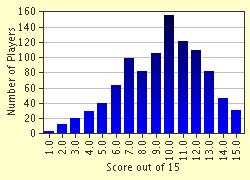Quiz Answer Key and Fun Facts
1. In January 1933 Hitler was lawfully appointed Chancellor of Germany by President Hindenburg.
2. On 27 February 1933 the Reichstag burned down. The Nazis were widely suspected of having caused the fire. Certainly, they had most to gain from it. Why?
3. In March 1933 the newly elected Reichstag passed the 'Enabling Act' ('Ermächtigungsgesetz'). What did this provide for?
4. Which of these played the leading role in 1933 in the Nazi campaign of terror?
5. What was the name popularly given to the secret police created by the Nazi regime in 1933-34?
6. The Nazis didn't actually call themselves by this name.
7. When did the Nazi régime start to issue antisemitic decrees?
8. In the 'Night of the Long Knives' (30 June-1 July 1934) Hitler had the leadership of one of the following organizations assassinated. Which was it?
9. After the summer of 1934 who became the head of the Nazi terror apparatus?
10. The first permanent concentration camp was established on 22 March 1933. Where?
11. In 1937 Germany bordered on ten foreign countries (plus the Free City of Danzig). Only one of these was NOT invaded or annexed by Germany. Which was it?
12. Nazi Germany started WWII (in Europe) on 1 September 1939 by invading one of its neighbors. Which country was it?
13. The Nazi regime was violently antisemitic from the outset. In which year did the systematic, mass extermination of the Jews start?
14. Which battle, more than any other, is widely seen (at least in Europe) as marking the beginning of the end for Nazi Germany?
15. VE Day (Victory in Europe Day) has been celebrated as a public holiday throughout Germany since about 1950.
Source: Author
bloomsby
This quiz was reviewed by our editing team before going online.
Any errors found in FunTrivia content are routinely corrected through our feedback system.

